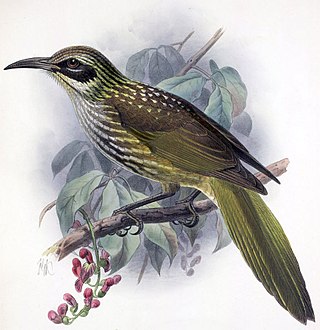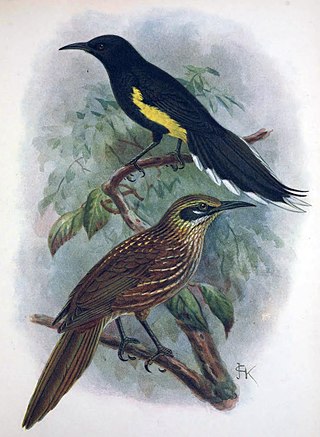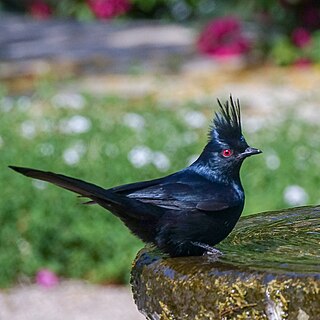| Cladogram based on Oliveros et al. (2019) [4] |
| Cladogram based on Kuhl et al. (2020) [5] |
| Corvoidea | |
|---|---|
 | |
| Chinspot batis Batis molitor (female) | |
| Scientific classification | |
| Domain: | Eukaryota |
| Kingdom: | Animalia |
| Phylum: | Chordata |
| Class: | Aves |
| Order: | Passeriformes |
| Infraorder: | Corvides |
| Superfamily: | Corvoidea |
| Families | |
See text | |
Corvoidea is a superfamily of birds in the order of Passeriformes.
Corvoidea contains the following families: [1] [2] [3]

The bird family Petroicidae includes 51 species in 19 genera. All are endemic to Australasia: New Guinea, Australia, New Zealand and numerous Pacific Islands as far east as Samoa. For want of an accurate common name, the family is often called the Australasian robins. Within the family species are known variously as robins, scrub-robins and flyrobins. They are only distantly related to the European robin of Europe, north Africa and western Asia, a member of family Muscicapidae.

The gnatcatchers are a family of small passerine birds called Polioptilidae. The 21 species occur in North and South America. Most species of this mainly tropical and subtropical group are resident, but the blue-grey gnatcatcher of the United States and southern Canada migrates south in winter. They are close relatives of the wrens.

The Eurylaimidae are a family of suboscine passerine birds that occur from the eastern Himalayas to Indonesia and the Philippines. The family previously included the sapayoa from the Neotropics, the asities from Madagascar, and the Calyptomenidae from Africa and Asia, but these are now separated into distinct families.

Estrildidae, or estrildid finches, is a family of small seed-eating passerine birds of the Old World tropics and Australasia. They comprise species commonly known as munias, mannikins, firefinches, parrotfinches and waxbills. Despite the word "finch" being included in the common names of some species, they are not closely related to birds with this name in other families, such as the Fringillidae, Emberizidae or Passerellidae.

Tichodroma is the only known genus in the family Tichodromidae. Initially, Linnaeus placed Tichodroma in the family Certhiidae, along with the treecreepers., while other authorities have placed it the nuthatch family Sittidae, as its own subfamily. A 2016 phylogenetic study of members in the superfamily Certhioidea suggests it is a sister of the Sittidae.

The kioea was a endemic Hawaiian bird that became extinct around the mid-19th century.

Spindalis is a genus consisting of four non-migratory species of bird. It is the only genus in the family Spindalidae. The species are mostly endemic to the West Indies; exceptions include populations of western spindalises on Cozumel Island, off the Yucatán Peninsula's east coast, and in extreme southeastern Florida. The species were traditionally considered aberrant members of the tanager family Thraupidae. Taxonomic studies recover them as a sister group to the Puerto Rican tanager, and some group Spindalidae and Nesospingidae within the Phaenicophilidae.

Erythrocercus is a genus of birds containing three flycatchers that are found in Africa.

The hylocitrea, also known as the yellow-flanked whistler or olive-flanked whistler, is a species of bird that is endemic to montane forests on the Indonesian island of Sulawesi. It is monotypic within the genus Hylocitrea, and has traditionally been considered a member of the family Pachycephalidae, but recent genetic evidence suggests it should be placed in a monotypic subfamily of the family Bombycillidae, or even its own family, Hylocitreidae. A 2019 study found it to be a sister group to a clade containing the hypocolius (Hypocoliidae) and the extinct Hawaiian honeyeaters (Mohoidae), with the clade containing all three being a sister group to the silky-flycatchers (Ptiliogonatidae). The divergences forming these families occurred in the early Miocene, about 20-23 million years ago.

Mohoua is a small genus of three bird species endemic to New Zealand. The scientific name is taken from mohua – the Māori name for the yellowhead. Their taxonomic placement has presented problems: They have typically been placed in the whistler family, Pachycephalidae, but in 2013 it was established that they are best placed in their own family, Mohouidae. A large molecular genetic study published in 2019 found that the family is sister to the family Neosittidae containing the three sittellas.

Mohoidae, also known as the Hawaiian honeyeaters, was a family of Hawaiian species of now recently extinct, nectarivorous songbirds in the genera Moho (ʻōʻō) and Chaetoptila (kioea). These now extinct birds form their own family, representing the only complete extinction of an entire avian family in modern times, when the disputed family Turnagridae is regarded as invalid. The last surviving species in the family, the Kauai O'o, became extinct after 1987.

Eurylaimides is a clade of passerine birds that are distributed in tropical regions around the Indian Ocean and a single American species, the sapayoa. This group is divided into five families. The families listed here are those recognised by the International Ornithologists' Union (IOC).

Muscicapoidea is a superfamily belonging to the infraorder Passerides containing the Old World flycatchers, thrushes, starlings and their allies. The superfamily contains around 670 species.

Tyrannides is a clade of passerine birds that are endemic to the Americas. The group likely originated in South America during the Eocene, about 45 million years ago.

Certhioidea is a superfamily belonging to the infraorder Passerida containing wrens and their allies. It was proposed in 2004 by Cracraft and colleagues to house a clade of four families that were removed from the superfamily Sylvioidea.

Bombycilloidea is a superfamily of passerine birds that contains ten living species. They are found in North, Central America, most of the Palearctic, the Arabian Peninsula, the islands of Hispaniola and Sulawesi, and formerly the Hawaiian Islands.

Hyliidae is a family of passerine birds which contains just two species, the green hylia and the tit hylia. Physiological similarities and molecular phylogenetic studies strongly support the creation of this family.

Eupasserines are passerines in the clade Eupasseres. The clade contains all passerines except the New Zealand wrens (Acanthisitti), to which they are sister.

Muscicapida is a clade of birds in the order Passeriformes. Oliveros, C.H. et al. (2019) suggested a gondwanan migration of this lineage from Australia to Eurasia.

Emberizoidea is a superfamily of passerines that are referred to as the New World nine-primaried oscines that includes majority of endemics which are exclusive to the New World. Nearly 892 species belong to this group as it includes buntings, American sparrows, the New World blackbirds, the parulid warblers, the cardinals, and the tanagers.